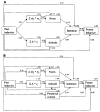Theories of reasoned action and planned behavior as models of condom use: a meta-analysis
- PMID: 11271752
- PMCID: PMC4780418
- DOI: 10.1037/0033-2909.127.1.142
Theories of reasoned action and planned behavior as models of condom use: a meta-analysis
Abstract
To examine how well the theories of reasoned action and planned behavior predict condom use, the authors synthesized 96 data sets (N = 22,594) containing associations between the models' key variables. Consistent with the theory of reasoned action's predictions, (a) condom use was related to intentions (weighted mean r. = .45), (b) intentions were based on attitudes (r. = .58) and subjective norms (r. = .39), and (c) attitudes were associated with behavioral beliefs (r. = .56) and norms were associated with normative beliefs (r. = .46). Consistent with the theory of planned behavior's predictions, perceived behavioral control was related to condom use intentions (r. = .45) and condom use (r. = .25), but in contrast to the theory, it did not contribute significantly to condom use. The strength of these associations, however, was influenced by the consideration of past behavior. Implications of these results for HIV prevention efforts are discussed.
Figures




References
-
- Adler NE, Kegeles SM, Irwin CE, Wibbelsman C. Adolescent contraceptive behavior: An assessment of decision processes. Journal of Pediatrics. 1990;116:463–471. - PubMed
-
- Agnew CR. Expanding the principle of correspondence: Predicting condom-relevant behaviors; Paper presented at the joint meeting of the European Association of Experimental Social Psychology and the Society for Experimental Social Psychology; Washington, DC. 1995. Oct,
-
- Ajzen I. From intentions to actions: A theory of planned behavior. In: Kuhl J, Beckman J, editors. Action control: From cognition to behavior. New York: Springer-Verlag; 1985. pp. 11–39.
-
- Ajzen I. Attitudes, personality and behavior. Chicago: Dorsey; 1988.
-
- Ajzen I. The theory of planned behavior. Organizational Behavior and Human Decision Processes. 1991;50:179–211.
Publication types
MeSH terms
Grants and funding
LinkOut - more resources
Full Text Sources
Miscellaneous

